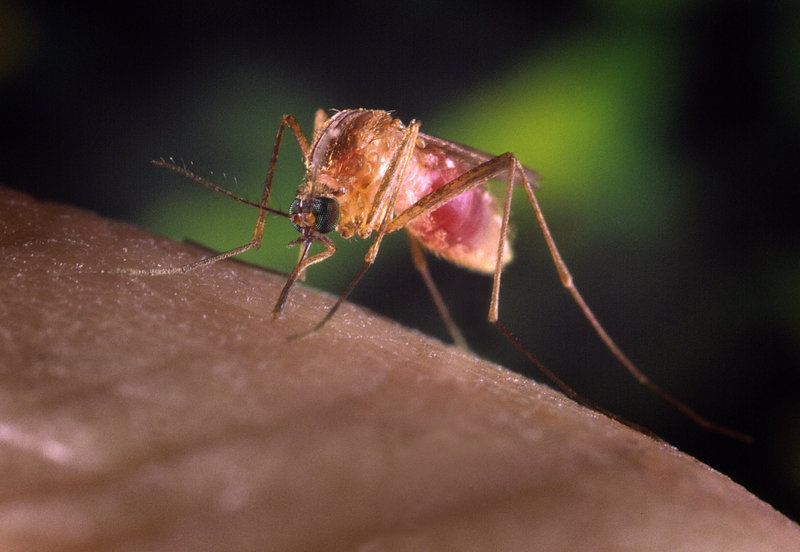Eastern Equine Encephalitis is hitting Maine harder than in any year since 2009, when the infection activity reached unprecedented proportions, say officials at the Maine Center for Disease Control and Prevention and the state Department of Agriculture, Conservation and Forestry.
Tests last week also documented the first case this year of West Nile virus, collected from a mosquito pool in Alfred, health officials said. Maine experienced its first confirmed human case of West Nile last year.
No human cases of EEE have ever been reported in Maine, but 13 more mosquito pools in southern Maine tested positive for the virus last week. The test results on new cases, announced by the Maine CDC on Monday, bring the total number of positive test pools for the disease to 21 this year.
“This is clearly increased activity for EEE this year,” said Dr. Stephen Sears, the state epidemiologist. “The numbers reflect that this year we’re seeing a lot more EEE. I find it concerning. What we’re all looking for is a little bit cooler weather.”
Forecasts for this week predict significantly cooler nights, in the mid-30s to low-30s for much of the state and the possibility of frost farther north.
The infected mosquito pools are located in York and Alfred in York County, which already had documented positive tests earlier this season, and in Kittery.
“Kittery was the new one,” Sears said. “Most were found in York.”
Maine CDC officials also said that a horse in Oxford County, another horse in York County and a pheasant in York County had died of EEE last week. No horses perished last year from the disease, but a flock of 30 pheasants was euthanized in Lebanon when the virus was detected in the birds.
This year’s level of EEE activity in mosquitoes, birds and horses has not been seen since 2009, when 10 horses succumbed to the infection, Sears said.
Assistant State Veterinarian Beth McEvoy underscored the need for proper and timely vaccinations for horses at risk of contracting EEE. Because vaccinations take time to provide protection, they must be given annually. Repellants, protective sheets and blankets also are recommended for horses.
EEE is a viral disease transmitted through the bite of an infected mosquito. The virus occurs in the eastern half of the United States and causes serious disease in five to 10 humans each year in the U.S., along with horses, some bird species and occasionally other mammals, including dogs. Because of the high mortality rate from EEE, the infection is regarded as one of the most serious mosquito-borne diseases in the country, health officials say.
Many persons infected with EEE manifest no obvious symptoms, but those who do develop illness are likely to experience a fever, chills and a headache, Sears said. Symptoms range from this type of mild, flu-like illness to more serious inflammation of the brain, coma and death. The progression of the disease is considered quite rapid, moving from fever to brain infection in some cases within a week. Patients who become seriously ill must be hospitalized to prevent debilitating permanent brain damage or death.
There is no specific treatment for EEE. The disease is best prevented by avoiding exposure to mosquitoes.
EEE has not yet been reported in a Maine resident. However, in 2008 a fatal case of EEE was diagnosed in a Massachusetts resident who may have acquired the infection while vacationing in Cumberland County, the Maine CDC reported.
EEE tends to concentrate in mosquito species that bite birds, but when their numbers increase substantially, species that act as “bridge vectors” are likely to influence the equation, too, causing a jump of the infection to larger birds, animals and humans, Sears said.
“Big birds are highly susceptible,” he said.
“Wet years with multiple mosquito crops” tend to create the conditions for more widespread EEE infection, Sears said. Periods of heavy rains this summer have contributed to the flourishing of mosquito populations in the state.
Many of the positive tests for EEE came from mosquito-pool locations that had already proven to be infected. That fact, combined with positive tests for both EEE and West Nile, increases the need to take preventive measures, said Sears.
Maine CDC officials re-emphasized steps people should take to protect themselves against EEE, West Nile virus and other mosquito-borne illnesses:
• Use an U.S. Environmental Protection Agency-approved repellent when outdoors, especially around dawn and dusk, and be sure to follow the instructions on the product’s label.
• Wear protective clothing when outdoors, including long-sleeved shirts, pants and socks.
• Keep window and door screens shut to keep mosquitoes out of the house.
• Limit time outdoors at dawn and dusk, when many species of mosquitoes are most active.
• Eliminate standing pools of water whenever possible. Empty containers holding water in and around the home, because water can attract mosquitoes.
“Mainers need to be aware of the risk of mosquitoes,” warned Dr. Sheila Pinette, director of Maine CDC. “EEE and WNV are very serious diseases, but they can be prevented by avoiding mosquito bites.”
While the threat of EEE and West Nile virus may have a daunting effect on attendance at outdoor evening events in southern and southwestern Maine, the threat from infected mosquitoes is not expected to hinder such events as the Common Ground Country Fair, which will be held more than 100 miles north in Unity. The fair, which typically attracts thousands of visitors, runs from Friday through Sunday.
The Maine CDC will continue to monitor and report information on mosquito-borne disease surveillance in Maine each week through September.
North Cairn can be contacted at 791-6325 or at:
ncairn@pressherald.com
Send questions/comments to the editors.



Comments are no longer available on this story